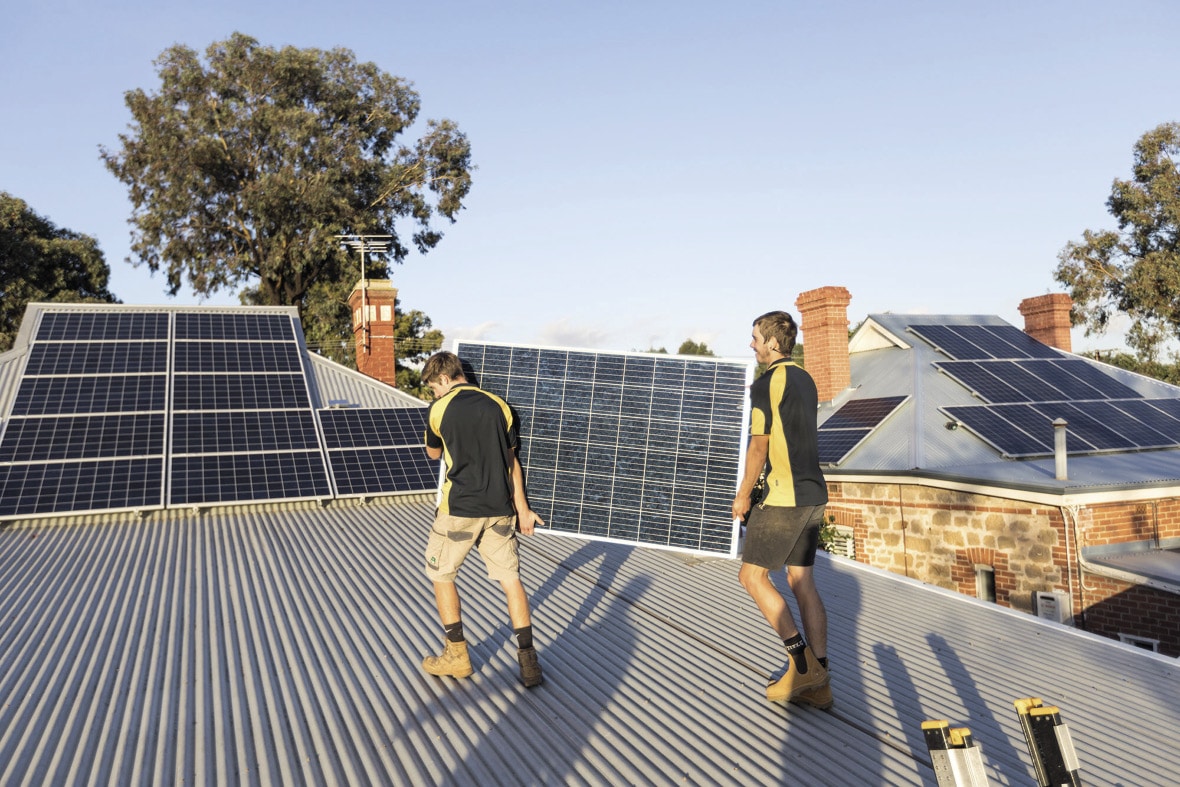Too much solar? In mid-2020, South Australia appeared to have a pending emergency on its hands. That is, in the spring, when the sun was building toward its peak – but battalions of air-conditioners weren’t yet in play – it was foreseeable that the state’s burgeoning rooftop solar supply would pump more electricity into the distribution wires than could be absorbed. Sunburn, or PV-driven blackout, was feared.
A rush to implement new regulations was undertaken, with requirements to remotely turn off (and turn on) rooftop solar systems installed from Sept. 28, 2020, onwards. The South Australian government brought in the regulations, as the states are responsible for electricity rules in the country. The move is expected to be a precursor to South Australia leading the world in the coordinated, smart management of distributed energy resources.
Big picture
Nigel Morris, head of business development at Solar Analytics – which has 45,000 of its Solar Smart Monitors installed on rooftop systems throughout Australia – says that he had long hoped to implement direct management of subscribers’ inverters to benefit consumers and the network. And, as such, the new regulations are exciting.
“It is wonderful to be in a country with a state like South Australia leading the way,” says Morris. “We have seen little examples of this in other parts of the world, where control of distributed generation has started to be orchestrated, but this is the first major, legally enforced, application of it.”
One in three homes in South Australia has rooftop solar, with an average of 2,500 new systems installed in the state every month throughout 2020.
In April, the Australian Electricity Market Operator (AEMO) formally foreshadowed grid-reliability issues on the horizon in its Renewable Integration Study Stage 1. It reported that distribution networks in the National Electricity Market (NEM), especially in South Australia and Western Australia, had begun to experience challenges in managing residential exports of electricity surpluses to household needs during the day.
AEMO said that higher penetration levels of distributed PV (DPV) “will ultimately flow into parts of the higher voltage sub-transmission and transmission networks.” The regulator characterised DPV not only as a resource, but as a growing threat. That’s because unlike large-scale renewable generators, rooftop solar inverters were not required to have voltage-disturbance ride-through capabilities. This means that thousands of inverters could trip at a voltage hurdle, turn off, and potentially leave sections of the grid without adequate electricity supply.
The extent of the DPV resource in South Australia has been demonstrated on several occasions. On Sept. 13, utility-scale and rooftop solar combined provided 89% of state demand. On Oct. 11, solar supplied 100% of the state’s energy needs, which inspired AEMO’s managing director and CEO at the time, Audrey Zibelman, to set the global context. “Never before has a jurisdiction the size of South Australia been completely run by solar power, with consumers’ rooftop solar systems contributing 77%,” she said.
On the loose
However, back in April 2020, Zibelman’s AEMO team wrote in its report that without reforms to support the ability to manage and coordinate rooftop solar, the regulator would increasingly need to impose capacity limits on passive DPV. This might translate into “moratoriums on new DPV installations or costly retrofit of existing DPV,” it said.
At the Clean Energy Council (CEC) –one of the bodies representing the renewables industry in Australia – Darren Gladman, CEC director of distributed energy, worked throughout 2020 with AEMO and other industry participants on a test procedure for short-duration, under-voltage ride-through capabilities. The capabilities were to be incorporated into new standards for inverters.
The organisations were working toward a late-November implementation date for the new standard. Gladman says this “was going to be challenging, but, we thought, just doable.” However, the South Australian state government moved first.
“The largest combined generator in our state is also actually an unmanaged generator,” South Australian Energy Minister Dan van Holst Pellekaan explained to the Australian Broadcasting Corp. at the time. “And that puts us at very real risk.”
Pellekaan announced a AUD 10 million ($7.6 million) government-funded upgrade to voltage management. “We will also need, for a few hours at a time, for a few times a year, to curtail some of the solar energy that goes into the grid.” He added that, unbeknownst to the Department of Energy and Mining, that up to one-third of all inverters in South Australia had automatically been switching off in response to voltage changes. “So we’re going to fix that,” he said.
Jenny Paradiso, managing director of Suntrix – one of the longest-running rooftop solar installers in South Australia and Victoria – recalls she was on her way to an extended weekend break when she received notification of the state government’s intention to accelerate proposed inverter requirements.
Despite the inopportune timing, Paradiso says she and other installers understood the need for the changes, but they could see right away that there were many unaddressed devils in the details. She and others suggested several alternative paths to the same outcome. Consultations with Pellekaan, however, resulted in an ultimatum – the gist of which, says Paradiso, echoed AEMO’s warning. “We either implement this, or we look at zero export, or we have blackouts. What do you want?”
Blunt end
In August, the South Australian government finalised its new rules for rooftop solar installations in the state, set to go into effect on Sept. 28. Suddenly, solar installers, retailers, and wholesalers were exposed to being saddled with inverter stock that might be non-compliant after the implementation date. Consumers were faced with headlines that spoke only of control mechanisms and a shutdown imperative to avoid blackouts.
The potential cost of compliance for consumers is also highly variable – depending on their choice of a “relevant agent” (some of which charge fees), their potential solar upgrade path, the number and duration of shutdowns in their area, and so on. One resounding feature of the development was the confusion that the new regulations caused. “They’ve been positioned as a brute-force instrument for emergencies,” says Morris.
Solar-industry participants most affected by the fast-forward, says Gladman, were SA Power Networks (South Australia’s network service provider), inverter manufacturers supplying the Australian market, and providers of technologies that integrate solar equipment with network providers and end users – companies such as Solar Analytics, SwitchDin, GreenSynch, and Redback Technologies.
Opportunity grows
Solar Analytics fast-tracked its collaboration with inverter manufacturer Sungrow to achieve interoperability between the inverters and its consumer-facing meters and app. As a result, the technology provider has been able to progress more quickly on integrating its systems with data received from Sungrow inverters. It is also able to make more dynamic and sophisticated decisions than switching solar off and then on again.
In October, immediately after the new regulations went into play, the AUD 4.84 million South Australian Power Networks Flexible Exports for Solar PV Trial – funded in part by the Australian Renewable Energy Agency (ARENA), and involving SA Power Networks – got underway. It involves inverter manufacturers Fronius, SMA and SolarEdge, and Australian energy-management and VPP software developer SwitchDin. It is investigating how SwitchDin’s flexible connection technology could allow rooftop solar inverters to export energy to the grid in direct response to network capacity to host that energy at any given time.
Never too much
Such dynamic solutions could potentially put an end to limits on the size of installed residential rooftop solar systems. Some parts of the Australian grid are already capped at 5 kWp of inverter capacity, to mitigate the rarely occurring, grid-threatening, over-abundance of solar-energy exports. Others have or are considering imposing zero-export rules on new participants. There has even been talk of charging households a fee to export solar, in order to fund grid upgrades.
The dynamic solution proposed by SwitchDin could also ensure that exports of excess energy – which attract various levels of feed-in tariffs, or time-of-export pricing in constrained areas – would be equally apportioned to all participants in a neighbourhood. This would facilitate the more equitable distribution of the benefits of rooftop solar systems – not just favouring early adopters.
ARENA estimated that the Flexible Exports for Solar PV Trial could pave the way for a doubling of rooftop solar in South Australia, while maintaining grid stability. Importantly, such dynamic solutions also enable ongoing decarbonisation, making sense of investments in electric vehicles (EVs) that can be recharged at the lowest cost in homes equipped with solar systems of appropriate size. When combined with intelligent energy management devices, EVs can become the solar sponges that also help to balance supply and demand for solar energy.
Solar Analytics’ Morris concludes that getting the new capabilities in before this summer, in case something went wrong, “was a pretty easy political win for the South Australian government.” He added that he gives them credit for their innovative thinking. “The control of potentially millions of distributed small-scale solar generation systems in Australia is really, really cool,” he says. “It means more grid stability and the potential for getting more solar onto the network.”
This content is protected by copyright and may not be reused. If you want to cooperate with us and would like to reuse some of our content, please contact: editors@pv-magazine.com.



Majority of people do not have cold showers. Raising the Temperature of the supply water in South Australia by 1 deg C would provide a way to soak up 500MWH of excess Solar PV instead of curtailment.
This heating can be done with industrial immersion heaters at the water storage tanks in the water supply system.
The heating will also reduce gas and electric water heating energy consumption at the consumer end.
This was suggested in 2020 to SA Government.
I will forever be amazed at the “abstract” problem solving ideas put forward, I dare say your (sound) idea would have rattled the thought processes of whomever received the suggestion – “too hard”, maybe, not so fast. Keep pushing Saugato, lets see where this idea goes. If I had the ability, I would seek more details…